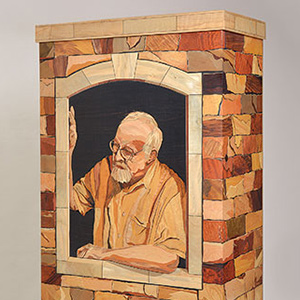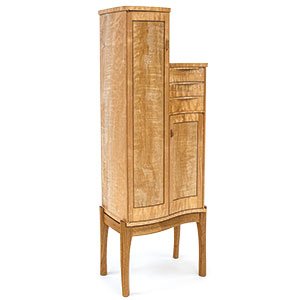More Maloof Memories
Jason Wheelan, Gregory Elder, Bill Gray, and Mike Raddatz reflect on Sam MaloofJason Wheelan: He always took the time
I flew down from North Idaho to see Sam with my Dad on a long weekend. We arrived there early for our tour and while we were waiting, Sam approached us and gave us a personal tour of the shop, the house, and then he invited us to attend a private lecture. When he shook my hand it was like a friend’s handshake that you have not seen in a while.
He spent about three hours with us only on that one Saturday. I had brought a couple of books hoping to have Sam sign them, and did he ever. Even at 93 his penmanship was to die for, perfect calligraphy. That day my Dad and I were floating on cloud nine. I had warm fuzzies from the second we stepped foot on the Maloof compound till I got in the car to leave. Thanks for the inspiration, the memories and mostly for being you. A warm, inviting friend that always took time to listen.
Gregory Elder, director of the Student Woodshop, Dartmouth College: Always a teacher
Sam Maloof’s friend Walker Weed occasionally brought Sam to the Student Workshops woodworking shop here at Dartmouth College. Walker was the Director of the Workshops from July 1964 until June 1981. On one such visit, I mentioned to Sam that there was something he might be interested in seeing. I reached under one of the benches and withdrew a pile of parts that looked like they would someday make a chair heavily influenced by Sam. Sam seemed pleased that a student had enough interest to copy his design. He looked at the parts carefully and started to comment when his wife, Alfreda, gently reminded Sam not be too critical of the student’s efforts. Sam mentioned a few places where more material could be removed as well as several other helpful hints. So I asked Sam if he would mind writing down his suggestions and he said, “sure.”
We placed the materials back under the bench and slipped Sam’s note (of course, signed by him) in between the layers of wood. When the student returned the next day, it was a moment to behold seeing the student discover that the master had visited, inspected his chair, and had given friendly advice on a few possible modifications.
Bill Gray: Sam and the teachers
Since the passing of Sam, much has been written about him, and deservedly so. However, most of it is about Sam and his woodworking. Few people know about his quiet contribution to industrial education and the teaching of woodworking in California’s schools. While attending a conference in the 1960s, I discovered Sam. A 35mm slide show, a presentation of his furniture, caught my attention. I was mesmerized. After seeing the beauty, warmth, and quality of his work, I changed my approach to teaching woodworking and furniture design.
Before my introduction to Sam’s work, my students would construct items and furniture from inexpensive wood. They would typically stain it and apply several coats of lacquer. That changed. If the students wanted furniture to look like walnut, we used walnut. If they wanted a maple look, we used maple. I introduced my classes to exposed joinery, using splines, plugs, wedges, and pegs of contrasting colors. Hand-rubbed penetrating oil finishes were in and lacquer was out. I took several classes on field trips to visit Sam, with the admonition to the students upon returning to school, “That is not how we use the bandsaw in this class.”
Other woodworking teachers were also influenced by Sam. In the 1970s and 1980s, arrangements were made to take groups of woodworking instructors to Sam’s shop and home as part of their professional development. He would spend a half day with us taking us through his shop, showing how he bandsawed chair arms, used templates, shaped his furniture, and applied his finish, and then join us for lunch in the garden area where he would continue to talk to the teachers and answer questions.
Fifteen years ago, with Sam’s permission, a Maloof Award was established. Every year since, at the California Industrial and Technology State Conference, this award was given to a woodworking teacher in recognition of lifetime achievement in the area of woodworking education. Often, when the conference was in Riverside, Calif., Sam would be there to present the award, a special occasion for the recipient.
During the past two years, the Maloof foundation hosted two groups of 45, mostly woodworking instructors. They were special events. Each year, upon discovering who we were, Sam joined the group. He took us in his shop before and after the tour and showed us his stash of hardwoods. And after that, sat around talking, answering questions, and signing anything brought to him, including scraps of wood. He was so giving of himself and his time. As a friend of mine said, “Sam and woodworking teachers were magic together.
Mike Raddatz: It’s a business
I had the privilege of attending one of Mr. Maloof’s workshops held at Highland Hardware in Atlanta, with one of my best friends back in 1999. On a break, I forward enough to ask him how much a rocker would cost. Some in the class thought my question was very inappropriate and said so. However, Mr., Maloof’s disagreed.
He stated “I sell furniture for a living! If I did not tell people how much it costs, how would I ever sell anything?” He then asked which chair I was interested in. Using his book, I pointed it out.
So, I learned that in 1999 the chair that I wanted would cost $17,000! I exclaimed “That is a lot of money for a chair!” He replied “If I wished, I could double the price and not materially affect the number of orders I get” However, he felt that this was fair. I then asked about delivery (at this point everyone in the class was listening, having decided that this was a very interesting discussion) He stated “It was 3 months to 3 years” and explained that his shop was a production shop, (for which he was sometimes criticized) however, he employed helpers (he called them his kids) and in the interest of efficiency e.g., when enough orders for chairs came in they made chairs! However, at that time he was making a table for the United Nations, and other custom work, so they would get their table before I got my chair!
I then asked “What is the deposit requirement?” He stated, “I don’t take deposits!”
I was shocked and stated “I would have to pay the entire amount up-front?”
He laughed and said “No, I will write down your order in my note book and call you when it is ready, shipping is free, but most people come and pick them up!”
I thought about that and asked “What happens if I don’t come and get the chair?”
He thought about that for a minute and shrugged stating “I have no idea. No one has ever not picked up an order!” As I was considering selling a kidney and placing that order, he went on with the following: “You are in this class for a reason. Do you have all the necessary tools? I replied that I did not have them on the same scale as his shop, but I could duplicate the function of all of his equipment.
“Then $17,000 will buy you one hell of a lot of wood,” he said, “and when you are finally finished, you will have two things, a chair inspired by mine and the knowledge of how to make another one just like it. However, if you are moved to order a chair made by me I would be honored to take fulfill your request.”
Fine Woodworking Recommended Products

Circle Guide

Compass

Drafting Tools





















Log in or create an account to post a comment.
Sign up Log in